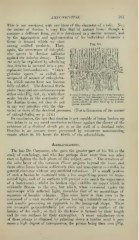Page 585 - My FlipBook
P. 585
AMELIFICA TION. 595 ;
This is not consistent with our ideas of the character of a tube. No
the nature of dentine is very like that of mature bone : tliough it
assumes a different form, yet it is developed in a similar manner, and
by the aggregation and agglomeration of its individual elements a
tissue is formed which we class
among ossified products. Then, l^ra. .•>
again, the occurrence of inten/lob-
ular spaces in dentine militates
against the tubular theory. These
can only be explained by admitting
that dentine is secreted into a pro-
toplasmic basis-substance. " Inter-
globular spaces," so called, are
composed of masses of calcoglobu-
lin, which masses have not become
fully calcified. The dentinal fibrils
pierce them and are continuous upon
either side (Fig. 331, c) ; while they A small Portion of the Dentine with Interglob-
ular Spaees (;i."iO diameters): c. portion of in-
make breaks in the continuity of
cremental line formed by the interglobular
the dentine tissue, yet they do not spaces, which are liere filled up by a trans-
parent material.
in any way interfere with the cha-
racter or form of the dentinal processes (For a discussion of the nature
of calcoglobulin, see p. 574.)
In conclusion, the fact that dentine is not capable of being broken up
into tubes is in my mind conclusive evidence against the theory of the
existence of a dentinal sheath per se as the wall of a dentinal tube.
Dentine is an osseous tissue permeated by numerous anastomosing
canals which in life locate the fibrils of the odontoblasts.
Amelification.
The late Dr. Carpenter, who gave the greater part of his life to the
study of conchology, and who has perhajxs done more than any other
man to lighten the dark places of tliis subject, says : " The structure of
the outer layer of the common Pinna projects beyond the inner, and
there often forms laminae sufficiently thin and transparent to exhibit its
general character without any artificial reduction. If a small portion
of such a lamina be examined with a low magnifving-power bv trans-
mitted light, each of its surfaces will present very much the appearance
of a honeycomb ; whilst its broken edge exhibits an as])ect which is
evidently fibrous to the eye, but which, when examined under the
microscope with^...x reflected liffht, resembles that of an assemblage of
„
xv...v.^.^v^.
^.g,
segments of basaltic columns. This outer layer is thus seen to be
composed of a vast number of prisvis having a tolerably uniform size
and usually presenting an approach to the hexagonal shape. These
are arranged perpendicularly (or nearly so) to the surface of the
lamina of the shell ; so that its thickness is formed by their length
and its two surfaces by their extremities. A more satisfactory view
of these prisms is obtained by grinding down a lamina until it pos-
sesses a high degree of transparence, the prisms being then seen (Fig.


